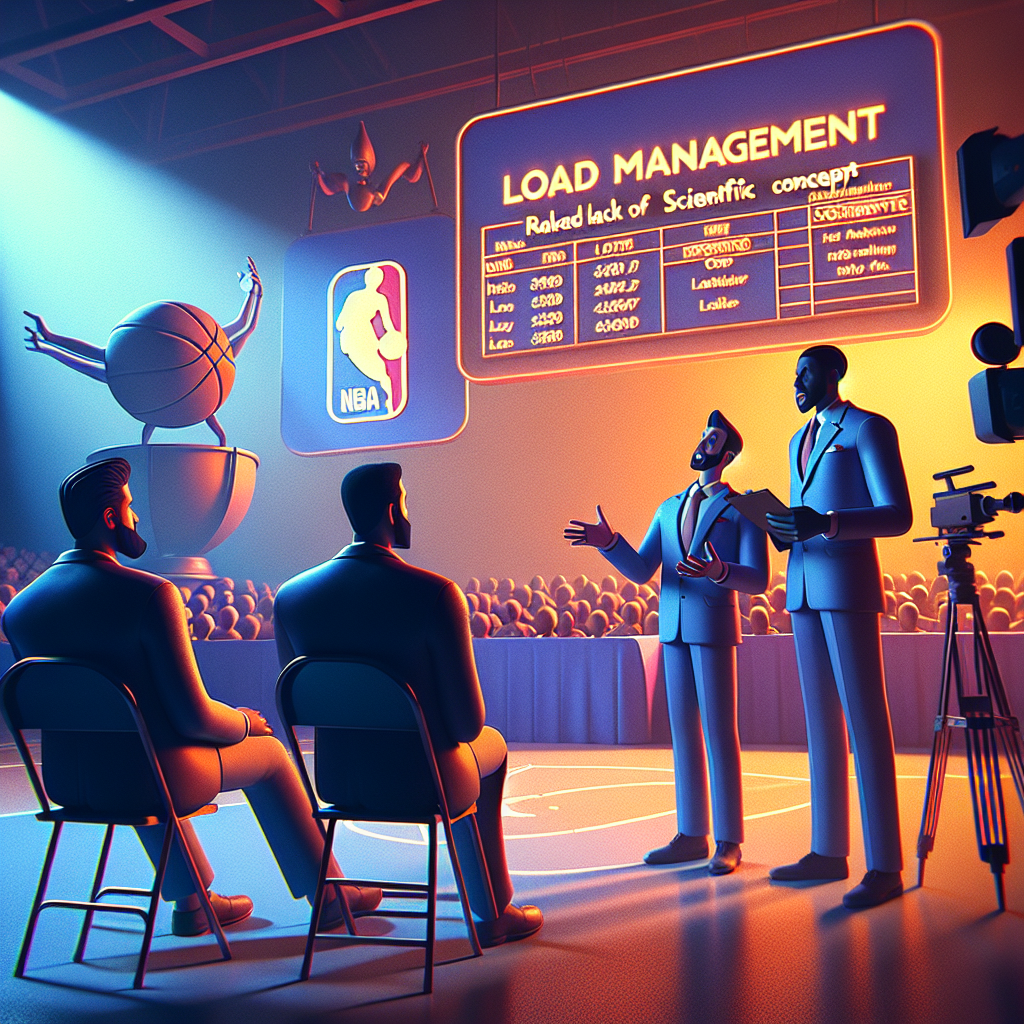NBA official: Load management no longer backed by scientific evidence

The Impact of Load Management on NBA Players’ Performance
Load management has been a hot topic in the NBA in recent years, with teams increasingly looking to rest their star players in order to prevent injuries and optimize performance. However, a recent statement from an NBA official has cast doubt on the effectiveness of load management as a strategy for improving player performance.
Load management, which involves carefully monitoring and controlling the amount of physical stress placed on a player’s body, has been touted as a way to reduce the risk of injury and improve overall performance. Proponents of load management argue that by giving players time to rest and recover, they can avoid overexertion and maintain peak physical condition throughout the season.
However, the NBA official in question has stated that load management is no longer backed by scientific evidence. This assertion raises questions about the validity of the practice and its impact on player performance. If load management is not supported by scientific research, then teams may need to reconsider their approach to managing player workload.
One of the key arguments in favor of load management is that it can help prevent injuries and prolong players’ careers. By reducing the amount of physical stress placed on a player’s body, teams hope to minimize the risk of overuse injuries and keep their star players healthy for the long haul. However, if load management is not supported by scientific evidence, then teams may need to explore other strategies for injury prevention.
Another potential benefit of load management is that it can help players maintain peak performance throughout the season. By giving players time to rest and recover, teams hope to avoid fatigue and ensure that their star players are able to perform at their best when it matters most. However, if load management is not backed by scientific research, then teams may need to rethink their approach to managing player workload in order to optimize performance.
In addition to its potential benefits, load management also has its critics. Some argue that resting star players can hurt the competitiveness of the league and diminish the fan experience. If teams are not able to rely on their best players to perform consistently, then the quality of the product on the court may suffer. However, if load management is not supported by scientific evidence, then teams may need to find a balance between resting players and maintaining a high level of competition.
Ultimately, the impact of load management on NBA players’ performance remains a topic of debate. While some believe that load management can help prevent injuries and optimize performance, others question its effectiveness and impact on the game. With the recent statement from an NBA official casting doubt on the practice, teams may need to reevaluate their approach to managing player workload in order to ensure the health and success of their star players.
Debunking the Myth: Scientific Evidence Against Load Management

Load management has been a hot topic in the NBA in recent years, with teams increasingly looking for ways to keep their star players fresh and healthy throughout the grueling 82-game season. The concept of load management involves strategically resting players during certain games or limiting their minutes in order to prevent injuries and optimize performance. However, a recent statement from an NBA official has cast doubt on the effectiveness of load management, suggesting that it is no longer backed by scientific evidence.
Load management gained popularity in the NBA after the Toronto Raptors famously employed the strategy with star player Kawhi Leonard during the 2018-2019 season. Leonard, who had a history of injuries, was rested for several games throughout the season in order to keep him fresh for the playoffs. The strategy paid off, as Leonard led the Raptors to their first NBA championship that year. Since then, other teams have followed suit, with players like LeBron James and Kevin Durant also benefiting from load management.
Proponents of load management argue that it can help prevent injuries and prolong players’ careers by reducing the wear and tear on their bodies. They point to studies that show a correlation between high minutes played and increased risk of injury. However, critics of load management argue that it can disrupt team chemistry and fan engagement, as well as potentially harm players’ competitive spirit.
The recent statement from an NBA official has added fuel to the debate, as it suggests that the scientific evidence supporting load management may not be as strong as previously thought. The official, who spoke on condition of anonymity, stated that recent studies have failed to show a clear link between load management and injury prevention. In fact, some studies have even suggested that excessive rest can actually increase the risk of injury by causing players to lose conditioning and rhythm.
While the official did not provide specific details about the studies in question, the statement has raised questions about the effectiveness of load management as a long-term strategy for player health and performance. It also highlights the need for more research in this area to better understand the impact of rest on athletes’ bodies.
Despite the lack of conclusive evidence, many NBA teams continue to use load management as a tool to manage their players’ workloads. Coaches and trainers often work closely with players to develop individualized plans that take into account factors such as age, injury history, and playing style. Some players have even embraced load management as a way to prolong their careers and stay competitive in the league.
In conclusion, the debate over load management in the NBA is far from settled. While some believe that it is a necessary tool for preserving players’ health and performance, others question its effectiveness and potential drawbacks. The recent statement from an NBA official adds a new layer to the discussion, highlighting the need for more research to determine the true impact of load management on athletes. As the NBA continues to evolve, it will be interesting to see how teams adapt their strategies in light of this new information.
NBA Official Guidelines on Player Rest and Recovery
Load management has been a hot topic in the NBA in recent years, with teams increasingly looking for ways to keep their star players fresh and healthy throughout the grueling 82-game season. However, a recent statement from a top NBA official has cast doubt on the effectiveness of load management as a strategy for player rest and recovery.
Load management, in simple terms, refers to the practice of carefully monitoring and controlling the amount of physical stress placed on a player’s body during games and practices. The idea is that by reducing the overall workload on a player, they can avoid injuries and perform at a high level for longer periods of time. This approach has gained popularity in recent years, with several high-profile players, including Kawhi Leonard and LeBron James, embracing the concept.
However, according to the NBA official, load management is no longer backed by scientific evidence. The official cited a lack of conclusive research showing that load management actually leads to a decrease in injuries or improved performance. This statement has sparked a debate within the league, with some teams and players questioning the validity of load management as a rest and recovery strategy.
Despite the skepticism surrounding load management, many teams continue to implement the practice as part of their overall player management strategy. Coaches and trainers argue that by carefully monitoring a player’s workload and giving them adequate rest, they can help prevent injuries and prolong a player’s career. Additionally, load management can be a valuable tool for managing the physical and mental fatigue that comes with the demands of a long NBA season.
While the effectiveness of load management may be up for debate, there is no denying the importance of rest and recovery in maintaining peak performance on the basketball court. NBA players are some of the most finely-tuned athletes in the world, and the demands of the game can take a toll on their bodies. Proper rest and recovery are essential for allowing players to recover from the physical and mental strain of playing at the highest level.
In addition to load management, there are several other strategies that teams can use to help their players recover and perform at their best. These include proper nutrition, hydration, and sleep, as well as regular stretching and strength training. By taking a holistic approach to player management, teams can help ensure that their players stay healthy and perform at a high level throughout the season.
Ultimately, the debate over load management in the NBA is likely to continue as teams search for the best ways to keep their players healthy and performing at their peak. While the scientific evidence may not definitively support load management as a rest and recovery strategy, it is clear that rest and recovery are essential components of player management in the NBA. By carefully monitoring their players’ workload and implementing a comprehensive rest and recovery plan, teams can help ensure that their players stay healthy and perform at their best on the court.

